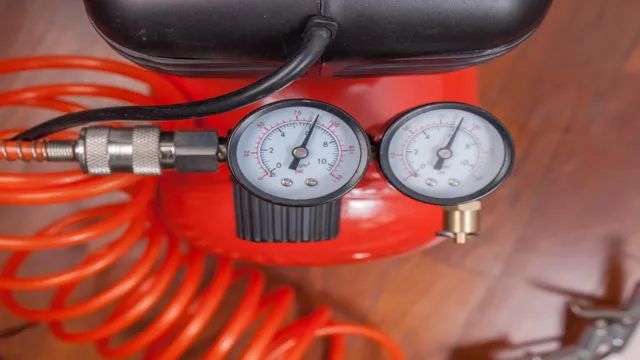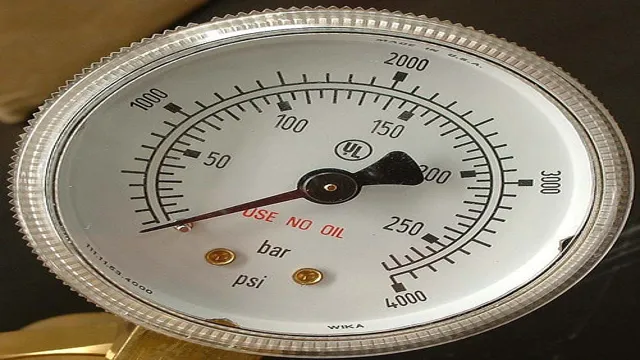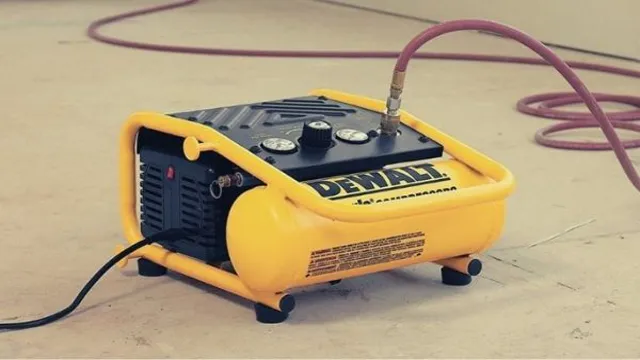What is SCFM on an Air Compressor? A Comprehensive Guide to Understanding SCFM

Air compressors are essential industrial machines that help facilitate various functions, from automotive applications to assembly lines. However, understanding the functionality and capabilities of an air compressor can be quite challenging, particularly when it comes to its output. One crucial aspect to consider when selecting an air compressor is its SCFM or Standard Cubic Feet per Minute rating.
But what exactly does SCFM mean, and why is it important? In this blog, we will delve into the basics of SCFM and its relation to air compressors. We will discuss the significance of SCFM as a measure of compressor output and how it affects various applications. Whether you are entirely new to air compressors or a seasoned user, this blog will help you gain a better understanding of SCFM and how it pertains to the functionality of your air compressor.
Defining SCFM
If you’re shopping for an air compressor and you’ve come across the acronym “SCFM,” you might be wondering what it means and how it relates to your purchase decision. Simply put, SCFM stands for “standard cubic feet per minute.” This measurement is used to describe the overall capacity of an air compressor to deliver air flow.
In other words, SCFM is a calculation of how much air a compressor can generate at a specific temperature, pressure, and humidity level. When shopping for an air compressor, it’s important to pay attention to the SCFM rating to ensure that it meets your needs. A compressor with a higher SCFM rating means that it can provide more air flow, which is particularly important if you’re working on larger projects or using air-powered tools that require a lot of air.
What does ‘SCFM’ stand for?
When it comes to understanding compressed air systems, one term that often gets thrown around is SCFM. SCFM stands for Standard Cubic Feet per Minute, which is a common unit of measurement used to describe a compressed air system’s airflow. It is a measure of the volume of air that a compressor can deliver at a standard temperature and pressure level.
This means that different compressors can have varying SCFM ratings, depending on the compressor’s size, pressure, and other factors. Understanding the SCFM rating of your compressor is essential when selecting the right equipment for your application. A higher SCFM rating means more air is delivered, which can lead to faster and more efficient work.
On the other hand, a lower SCFM rating may not be sufficient for your needs. So, the next time you hear the term SCFM, you’ll know exactly what it means.

Why is SCFM important?
When it comes to understanding the output of an air compressor or any other pneumatic tools, you may come across the term SCFM. SCFM stands for Standard Cubic Feet per Minute and is a measure of the volume of air being delivered by the compressor at a standard temperature and pressure, usually 68 degrees Fahrenheit and 17 pounds per square inch.
The importance of SCFM lies in its ability to help you determine how much air your tools require and how much your compressor can deliver. By matching the SCFM of your compressor with the requirements of your tools, you can ensure efficient and optimal operation. Knowing the SCFM rating is also essential when comparing different compressors to figure out which one is best suited for your needs.
Therefore, whether you’re working in industrial settings, automotive shops, or simply using pneumatic tools at home, understanding the significance of SCFM can make your work more productive and efficient.
How SCFM is Calculated
“What is SCFM on an air compressor?” SCFM stands for Standard Cubic Feet per Minute and it represents the amount of air an air compressor can deliver at a given pressure. To calculate SCFM, manufacturers use a standard set of conditions including room temperature, barometric pressure, and relative humidity. This ensures that all air compressors can be compared using the same standard.
It is important to note that as pressure increases, the SCFM of an air compressor decreases, meaning it delivers less air at a higher pressure. It is also important to choose an air compressor with a suitable SCFM for the tools and applications you will be using it for. Make sure to consider both the maximum SCFM and the compressor’s duty cycle when making your decision.
The basics of air compressor ratings
Air compressor ratings are essential to know when purchasing one for your needs. One of the critical ratings to consider is Standard Cubic Feet per Minute or SCFM. This rating determines the airflow capacity of the compressor and how much air it can deliver per minute.
SCFM is calculated based on the inlet air temperature, pressure and humidity, and the outlet air temperature, pressure, and volume. This rating is vital in determining the compressor’s efficiency, as the higher the SCFM, the faster it can power air tools and equipment. Understanding SCFM is crucial in selecting the right compressor for your project.
A compressor with a low SCFM rating may not deliver sufficient output, while an oversized compressor with a high SCFM rating may be costly and energy inefficient for smaller tasks. It is essential to know the appropriate SCFM rating required for your particular needs to make an informed purchase.
Factors that affect SCFM
SCFM calculation When it comes to determining the SCFM, several factors come into play. The primary factor is the amount of air flowing through the system at any given time. This involves measuring the flow rate of compressed air in cubic feet per minute (CFM), which is then corrected for specific temperature, pressure, and humidity conditions to get the SCFM value.
Additionally, the type of compressor used and its efficiency also play a crucial role in the SCFM calculation. If the compressor is not working efficiently, the output of the air will be lower, resulting in a lower SCFM value. Moreover, the size and length of the piping used in the system, the number of bends and changes in direction of the piping, as well as any obstructions in the airflow path, can also influence the SCFM calculation.
Therefore, it is essential to consider these factors when calculating the SCFM to ensure an accurate measurement of the compressed air flow rate through a system.
The Relationship Between SCFM and CFM
If you’re shopping for an air compressor, you may have come across the term “SCFM.” SCFM stands for Standard Cubic Feet per Minute, and it’s a measurement used to describe the airflow rate of an air compressor. CFM, or Cubic Feet per Minute, is a similar measurement that’s also used to describe airflow.
However, the two measurements are not interchangeable. SCFM takes into account the standard conditions of temperature, pressure, and relative humidity, while CFM does not. This means that when you’re comparing two air compressors, you should look for their SCFM ratings instead of their CFM ratings, as SCFM is a more accurate representation of their actual airflow capacity.
So, if you want to make sure you’re getting an air compressor that can meet your needs, it’s important to pay attention to its SCFM rating.
Understanding the difference between SCFM and CFM
SCFM; CFM When it comes to measuring airflow, two terms that often come up are SCFM and CFM, which stand for standard cubic feet per minute and cubic feet per minute, respectively. The main difference between these two measurements is that SCFM is adjusted to a standard temperature and pressure, whereas CFM is not. This means that SCFM takes into account the density of the air, which can affect the volume of air that actually flows through a system.
For instance, if air is flowing through a system that is elevated or located at high altitudes, the lower density of air can cause a decrease in CFM. On the other hand, SCFM will compensate for this and give a more accurate representation of the actual flow rate. In general, SCFM is especially important when it comes to applications such as industrial manufacturing, where precise air flow measurements are crucial to ensure efficient and optimal production.
Why CFM is not always the best measure of performance
When it comes to measuring the performance of an air compressor, CFM (cubic feet per minute) is often seen as the go-to metric. However, CFM may not always be the best measure of performance, especially when compared to SCFM (standard cubic feet per minute). The main difference between the two is the reference point for the measurement.
CFM measures the amount of air delivered at the compressor’s output, whereas SCFM measures the amount of air delivered at a standard set of conditions (typically 68 degrees Fahrenheit and 17 psi). This means that CFM can vary depending on the temperature and humidity of the surrounding environment, which can affect the density of the compressed air and thus its volume.
On the other hand, SCFM provides a more standardized measurement that takes into account these environmental variables. So, if you want a more accurate representation of your compressor’s performance, it may be worth considering SCFM as well as CFM.
Choosing the Right Air Compressor for Your Needs
When it comes to choosing the right air compressor for your needs, it’s important to understand what SCFM means. SCFM stands for Standard Cubic Feet per Minute, and it’s a measurement of the airflow rate that an air compressor can deliver. Essentially, it indicates how much air an air compressor can pump out in a given amount of time.
This is an important factor to consider when selecting an air compressor because it directly affects the tools and equipment that you can use with it. If you need to use tools that require a high airflow rate, you’ll need an air compressor with a higher SCFM rating. Conversely, if you only need to use tools that require a lower airflow rate, you can get away with using an air compressor with a lower SCFM rating.
Ultimately, understanding SCFM will help you choose the right air compressor for your specific needs.
How to select the right SCFM for your application
When choosing an air compressor for your needs, one of the most important factors to consider is the SCFM, or standard cubic feet per minute, rating. This measures the volume of air the compressor can deliver at a given pressure and temperature. If you choose an air compressor with an SCFM that is too low for your needs, you may experience a lack of power or efficiency.
On the other hand, if you choose an air compressor with an SCFM that is too high, you may be overspending on equipment that you don’t actually need. The best approach is to carefully evaluate your specific application and determine the SCFM rating that will provide optimal performance without breaking the bank. By doing your research and selecting the right air compressor for your needs, you can ensure that your projects run smoothly and efficiently, saving you both time and money in the long run.
Conclusion
In conclusion, SCFM on an air compressor is the measure of the amount of air a compressor can deliver at a given PSI and temperature. So think of SCFM like the superhero cape on an air compressor – it’s the measurement that lets you know just how much air power you’ve got at your disposal. Without it, you’d be as powerless as a balloon without helium.
So the next time you’re considering an air compressor, remember that a high SCFM rating means you’ll be able to tackle even the toughest pneumatic challenges with ease. It’s time to suit up and unleash your inner pneumatic superhero!”
FAQs
What does SCFM stand for in relation to air compressors?
SCFM stands for “standard cubic feet per minute”, which is a unit of measurement used to describe the volume of air flow in an air compressor under standard conditions.
How is SCFM calculated?
SCFM is calculated based on the volume of compressed air that an air compressor can deliver at a specific pressure and temperature.
What is the difference between SCFM and CFM?
While both SCFM and CFM measure the flow rate of compressed air in an air compressor, SCFM is measured under standard conditions of pressure and temperature, while CFM is not.
Why is SCFM important in selecting the right air compressor?
Understanding the SCFM rating of an air compressor is crucial in selecting the right size of compressor for your specific application. Without sufficient SCFM, your tools or equipment may not receive the necessary air flow to operate properly.
What factors affect the SCFM of an air compressor?
The SCFM of an air compressor can be influenced by a number of factors including the compressor’s motor size, tank size, and the length and diameter of the air hose.
How can you increase the SCFM of an air compressor?
The easiest way to increase the SCFM of an air compressor is to invest in a larger compressor with a bigger motor and tank size. Additionally, upgrading to a larger diameter air hose can also increase SCFM.
Can you convert SCFM to other units of measurement?
Yes, SCFM can be converted to other units of measurement, such as CFM, by using standard conversion formulas. However, it is important to note that these conversions may not accurately reflect the true flow rate and performance of your air compressor.




